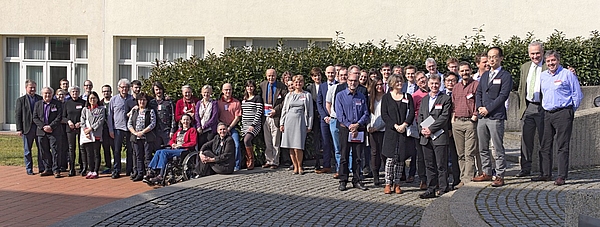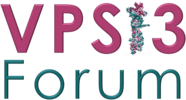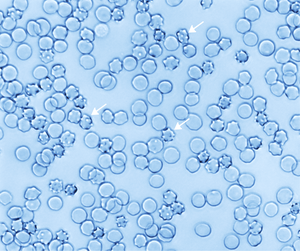Neuroacanthocytosis syndromes and neurodegeneration with iron accumulation in the brain
Special consultation for neuroacanthocytosis syndromes and neurodegeneration with iron accumulation in the brain
In this special consultation we deal with clinical and scientific aspects of neuroacanthocytosis syndromes and neurodegeneration with brain iron accumulation (NBIA, engl. Neurodegeneration with Brain Iron Accumulation).
- National specialized patient care (diagnostics and therapy)
- Advice on social and life-practical aspects of the diseases
- Implementation of national and international studies (clinical and basic scientific issues)
We diagnose, treat and accompany outpatients who suffer from these diseases or for whom such a diagnosis is possible. If necessary, inpatient or day-clinic stays are organized for diagnostics and therapy. In addition to symptomatic therapy, one of our goals is the development and testing of novel therapy methods and options and thus the early transfer (translation) of basic scientific knowledge into clinical application.
We are always available to deal with concerns from those affected and medical colleagues alike.
Consultation hour:
By appointment
Neurology Polyclinic from University Medical Center Rostock
Appointment arrangement:
Your contact person:

Dr. med. Kevin Peikert
Section for Translational Neurodegeneration "Albrecht Kossel"
Kevin.Peikert{bei}med.uni-rostock.de

Prof. Dr. Dr. Andreas Hermann
Section for Translational Neurodegeneration "Albrecht Kossel"
sektionsleiter.akos{bei}med.uni-rostock.de
We are a supporting partner of the European Rare Disease Network (ERN-RND) (Kopie 1)
European reference network (ERN):
www.ern-rnd.eu
Neuroacanthocytosis syndromes include rare genetic (hereditary) neurodegenerative diseases - such as chorea-acanthocytosis (VPS13A disease) and McLeod syndrome (XK disease). Among other things, they can lead to movement disorders (chorea, dystonia, parkinsonism), epilepsy and cognitive deficits as well as changes in the blood count (acanthocytosis, see figure). Swallowing and speaking disorders, behavioral and personality changes also occur. Muscles (myopathy) and peripheral nerves (neuropathy) can also be affected by the disease. Patients typically become ill in early to middle age. The course is chronic and progressive.
The two nuclear neuroacanthocytosis syndromes are triggered by mutations in the VPS13A and XK genes. The respective proteins together form a functional complex at membrane contact points, where they are involved in the so-called "mass transfer of lipids". This explains the similarity between the two diseases. VPS13A belongs to a new superfamily of proteins called "bridge-like lipid transfer proteins" (BLTP). These proteins are of great research interest because some of them are involved in the development of neurological diseases. In addition to VPS13A, these include VPS13C (associated with Parkinson's syndromes) and VPS13D (associated with ataxia syndromes).
The term Neurodegeneration with Brain Iron Accumulation (NBIA) also encompasses a group of rare neurodegenerative genetic disorders. The main representative is pantothenate kinase-associated neurodegeneration (PKAN). The diseases have in common that there is an abnormal accumulation of iron, primarily in the basal ganglia of the brain. Children usually develop the classic form of PKAN before they are 6 years old. Symptoms can include a gait disorder with falls (spasticity, dystonia) and impaired vision (retinitis pigmentosa). Acanthocytes are also found in the blood count of some patients with PKAN, so that this disease was also counted among the neuroacanthocytosis syndromes (see above) in the past.
The differential diagnostics is complex and includes a multimodal procedure, which, in addition to the clinical examination and anamnesis, includes imaging (e.g. MRI of the head) and laboratory methods (e.g. acanthocyte screening according to Storch et al. 2005, Chorein-Western Blot), electrophysiological examinations (EEG , ENG, EMG) and genetic testing.
Due to the rarity of the diseases, the scientific evidence for therapeutic approaches is low. Unfortunately, there are still no therapies available that can significantly modify the course of the disease or even lead to a cure. However, there are a number of symptom-relieving drug and non-drug therapy options (e.g. physiotherapy, ergotherapy, speech therapy, in individual cases deep brain stimulation) that can be used depending on the symptoms and the stage of the disease.
Für nähere Informationen empfehlen wir die folgende Fachliteratur:
- Peikert K et al. 2023: Neuroakanthozytose-Syndrome und Co. Neurodegeneration durch gestörten Massentransfer von Lipiden. DNP. Link
- Jung HH et al. 2021: McLeod Neuroacanthocytosis Syndrome. GeneReviews® [Internet]. Link
- Peikert K et al. 2023: VPS13A Disease. GeneReviews® [Internet]. Link
Current projects (selection):
- Translational identification of drug targets in chorea acanthocytosis
- Investigations into biomarkers and to improve diagnostics for neuroacanthocytosis syndromes
- Studies on the natural course of the disease
- Cell biological studies on the "mass transfer" of lipids to membrane contact points by BLTPs/VPS13 proteins, including using neuronal cell culture models (from inducible pluripotent stem cells) with disease-causing mutations in the VPS13 gene family
Patients who are interested in scientific studies can find out more about this at an outpatient appointment.
EMINA-2
The "European Multidisciplinary Initiative on Neuroacanthocytosis" was an international consortium dedicated to researching the molecular pathophysiology of chorea acanthocytosis. It was funded under the 2009 E-Rare program. Prof. Andreas Hermann was the coordinator of the consortium.
Cooperation partners (selection)
Prof. Dr. Margit Burmeister, University of Michigan, USA
Prof. Dr. Pietro De Camilli, Yale University, USA
Prof. Dr. Adrian Danek, LMU Munich, Germany
Prof. Dr. Michael Föller, University of Halle, Germany
Prof. Dr. Lucia De Franceschi, University of Verona, Italy
Prof. Dr. Lars Kaestner, Saarland University, Germany
Prof. Dr. Timo Kirschstein, Rostock University Medical Center, Germany
Prof. Dr. Donatienne Tyteca, Université Catholique de Louvain, Belgium
Prof. Dr. Silvio Quick, Chemnitz Clinic, Germany
Prof. Dr. Ruth H. Walker, James J. Peters Veterans Affairs Medical Center, Bronx, and Mount Sinai School of Medicine, New York, USA
Peikert K, Dobson-Stone C, Rampoldi L, Miltenberger-Miltenyi G, Neiman A, De Camilli P, Hermann A, Walker RH, Monaco AP, Danek A. VPS13A Disease. 2002 Jun 14 [updated 2023 Mar 30]. In: Adam MP, Mirzaa GM, Pagon RA, Wallace SE, Bean LJH, Gripp KW, Amemiya A, editors. GeneReviews® [Internet]. Seattle (WA): University of Washington, Seattle; 1993–2023. PMID: 20301561.
Peikert K, Danek A. VPS13 Forum Proceedings: XK, XK-Related and VPS13 Proteins in Membrane Lipid Dynamics. Contact (Thousand Oaks). 2023 Feb 23;6:25152564231156994.
Peikert K, Storch A, Hermann A, Landwehrmeyer GB, Walker RH, Simionato G, Kaestner L, Danek A. Commentary: Acanthocytes identified in Huntington's disease. Front Neurosci. 2022 Nov 4;16:1049676. doi: 10.3389/fnins.2022.1049676.
Recktenwald SM, Lopes MGM, Peter S, Hof S, Simionato G, Peikert K, Hermann A, Danek A, van Bentum K, Eichler H, Wagner C, Quint S and Kaestner L. Erysense, a Lab-on-a-Chip-Based Point-of-Care Device to Evaluate Red Blood Cell Flow Properties With Multiple Clinical Applications. Front. Physiol. April 2022; 13:884690
Reichel F, Kräter M, Peikert K, Glaß H, Rosendahl P, Herbig M, Rivera Prieto A, Kihm A, Bosman G, Kaestner L, Hermann A, Guck J. Changes in Blood Cell Deformability in Chorea Acanthocytosis and Effects of Treatment With Dasatinib or Lithium. Front. Physiol. April 2022 13:852946.
Peikert K, Hermann A, Danek A. XK-Associated McLeod Syndrome: Nonhematological Manifestations and Relation to VPS13A Disease. Transfus Med Hemother 2022;49:4-12.
Federti E, Matte A, Riccardi V, Peikert K, Alper SL, Danek A, Walker RH, Siciliano A, Iatcenko I, Hermann A, De Franceschi L. Adaptative Up-Regulation of PRX2 and PRX5 Expression Characterizes Brain from Mouse Model of Chorea-Acanthocytosis. Antioxidants. 2022; 11(1):76.
Jung HH, Danek A, Walker RH, Frey BM, Peikert K. McLeod Neuroacanthocytosis Syndrome. In: Adam MP, Ardinger HH, Pagon RA, Wallace SE, Bean LJH, Gripp KW, Mirzaa GM, Amemiya A, editors.GeneReviews® [Internet]. Seattle (WA): University of Washington, Seattle; 1993–2021. 2004 Dec 3 [updated 2021 Sep 16].
Quick S, Heidrich FM, Winkler MV, Winkler AH, Ibrahim K, Linke A, Speiser U, Grabmaier U, Buhmann C, Marxreiter F, Saft C, Danek A, Hermann A, Peikert K. Cardiac manifestation is evident in chorea-acanthocytosis but different from McLeod syndrome. Parkinsonism Relat Disord. 2021 Jul;88:90-95.
Peikert K*, Federti E*, Matte A, Constantin G, Pietronigro EC, Fabene PF, Defilippi P, Turco E, Del Gallo F, Pucci P, Amoresano A, Illiano A, Cozzolino F, Monti M, Garello F, Terreno E, Alper SL, Glaß H, Pelzl L, Akgün K, Ziemssen T, Ordemann R, Lang F, Brunati AM, Tibaldi E, Andolfo I, Iolascon A, Bertini G, Buffelli M, Zancanaro C, Lorenzetto E, Siciliano A, Bonifacio M, Danek A, Walker RH, Hermann A*, De Franceschi L*. Therapeutic targeting of Lyn kinase to treat chorea-acanthocytosis. Acta Neuropathol Commun. May 2021; 9:81. doi:10.1186/s40478-021-01181-y . *contributed equally.
Peikert K, Glaß H, Federti E, Matte A, Pelzl L, Akgün K, Ziemssen T, Ordemann R, Lang F, The Network for Translational Research for Neuroacanthocytosis Patients, De Franceschi L*, Hermann A*. Targeting Lyn Kinase in Chorea-Acanthocytosis: A Translational Treatment Approach in a Rare Disease. Journal of Personalized Medicine. May 2021; 11(5):392. doi.org/10.3390/jpm11050392 . *contributed equally.
Rabe A*, Kihm A*, Darras A*, Peikert K*, Simionato G*, Dasanna AK*, Glaß H, Geisel J, Quint S, Danek A, Wagner C, Fedosov DA, Hermann A, Kaestner L. The Erythrocyte Sedimentation Rate and Its Relation to Cell Shape and Rigidity of Red Blood Cells from Chorea-Acanthocytosis Patients in an Off-Label Treatment with Dasatinib. Biomolecules. May 2021; 11(5):727. doi.org/10.3390/biom11050727 . *contributed equally.
Darras A*, Peikert K*, Rabe A, Yaya F, Simionato G, John T, Dasanna AK, Buvalyy S, Geisel J, Hermann A, Fedosov DA, Danek A, Wagner C, Kaestner L. Acanthocyte Sedimentation Rate as a Diagnostic Biomarker for Neuroacanthocytosis Syndromes: Experimental Evidence and Physical Justification. Cells. April 2021; 10(4):788. doi.org/10.3390/cells10040788 . *contributed equally
Peikert K, Akgün K, Beste C, Ziemssen T, Buhmann C, Danek A, Hermann A., Neurofilament light chain in serum is significantly increased in chorea-acanthocytosis. Parkinsonism Relat Disord. 2020 Sep 7;80:28-31. doi: 10.1016/j.parkreldis.2020.09.004 . Epub ahead of print.
Glaß H, Neumann P, Pal A, Reinhardt P, Storch A, Sterneckert J, Hermann A. Combined Dendritic and Axonal Deterioration Are Responsible for Motoneuronopathy in Patient-Derived Neuronal Cell Models of Chorea-Acanthocytosis. Int. J. Mol. Sci. 2020 March 5, 21(5), 1797; doi: 10.3390/ijms21051797 Free Full Text
Peikert K, Danek A, Hermann A. Current state of knowledge in Chorea-Acanthocytosis as core Neuroacanthocytosis syndrome. European Journal of Medical Genetics. 2018;61(11):699-705.
Peikert K, Hermann A. Proceedings of the Ninth International Meeting on Neuroacanthocytosis Syndromes. Tremor and other hyperkinetic movements (New York, NY). 2018;8:579.
Glass H, Pal A, Reinhardt P, …, Storch A, Hermann A. Defective mitochondrial and lysosomal trafficking in chorea-acanthocytosis is independent of Src-kinase signaling. Molecular and cellular neurosciences. 2018;92:137-148.
Hermann A. Neuroacanthocytosis syndromes, in: C., F.-P., J., F., P., M.-M., K, C. (Eds.), Movement Disorders Curricula. Springer, Vienna, 2017.
Hermann A & Walker RH. Diagnosis and Treatment of Chorea Syndromes; Current Neurology and Neuroscience Reports, Jan 2015, 15:1
Hermann A, Chapter 3: Chorea-acanthocytosis, in Chorea, F.E. Micheli, P.A. LeWitt (eds.), Springer, 2017, p.31-55
Stanslowsky N*, Reinhardt P*, Glass H, Kalmbach N, Naujock M, Lübben V, Hensel N, Pal A, Venneri A, De Franceschi L, Claus P, Sterneckert J, Storch A, Hermann A*, Wegner F*. Neuronal dysfunction in iPSC-derived medium spiny neurons from Chorea-Acanthocytosis patients is reversed by Src kinase inhibition and F-actin stabilization, J Neurosci, 2016 Nov 23;36(47):12027-12043., *contributed equally
Pelzl L, Elsir B, Sahu I, Bissinger R, Singh Y, Sukkar B, Honisch S, Schoels L, Jemaà M, Lang E, Storch A, Hermann A, Stournaras C, Lang F. Lithium Sensitivity of Store Operated Ca2+ Entry and Survival of Fibroblasts Isolated from Chorea-Acanthocytosis Patients. Cell Physiol Biochem. 2017 Aug 11;42(5):2066-2077.
Föller M*, Hermann A*, Gu S, Alesutan I, Qadri SM, Borst O, Schmidt E-M, Schiele F, Müller vom Hagen I, Saft C, Schöls L, Lerche H, Stournaras C, Storch A*, Lang F*, 2012, Chorein-sensitive polymerization of cortical actin and suicidal cell death in chorea-acanthocytosis, FASEB J. 26(4): 1526-1534 *contributed equally
Pappas SS, Bonifacino J, Danek A, Dauer WT, De M, De Franceschi L, DiPaolo G, Fuller R, Haucke V, Hermann A, Kornmann B, Landwehrmeyer B, Levin J, Neiman AM, Rudnicki DD, Sibon O, Velayos-Baeza A, Vonk JJ, Walker RH, Weisman LS, Albin RL. Eighth International Chorea–Acanthocytosis Symposium: summary of workshop discussion and action points. Tremor Other Hyperkinet Mov. 2017; 15;7:428.
Lupo F, Tibaldi E, Matte A, Sharma AK, Brunati AM, Alper SL, Zancanaro C, Benati D, Siciliano A, Bertoldi M, Zonti F, Storch A, Walker RH, Danek A, Bader B, Hermann A, De Franceschi L. Impaired autophagy is involved in abnormalities of erythroid cells from patients with chorea-acanthocytosis. Blood, 2016 Dec 22;128(25):2976-2987.
Honisch S, Gu S, Vom Hagen JM, Alkahtani S, Al Kahtane AA, Tsapara A, Hermann A, Storch A, Schöls L, Lang F, Stournaras C. Chorein Sensitive Arrangement of Cytoskeletal Architecture. Cell Physiol Biochem. 2015;37(1):399-408.
Siegl C, Hamminger P, Jank H, Ahting U, Bader B, Danek A, Gregory A, Hartig M, Hayflick S, Hermann A, Prokisch H, Sammler EM, Yapici Z, Prohaska R, Salzer U. Alterations of red cell membrane properties in neuroacanthocytosis. PLoS One. 2013 Oct 3;8(10):e76715.
Schmidt EM, Schmid E, Münzer P, Hermann A, Eyrich AK, Russo A, Walker B, Gu S, Müller Vom Hagen J, Faggio C, Schaller M, Föller M, Schöls L, Gawaz M, Borst O, Storch A, Stournaras C, Lang F, Chorein sensitivity of cytoskeletal organization and degranulation of platelets. FASEB J., 27(7):2799-806

In 2018, our working group organized the 9th International Symposium on Neuroacanthocytosis Syndromes with the participation of world-leading scientists and affected families in Dresden-Radebeul.
The congress program including accepted abstracts can be found here.
Further symposia are usually held every two years at different conference locations. The next "International Meeting on Neuroacanthocytosis Syndromes" will be organized by Prof. Dr. Lars Kaestner, from 15.-17. September 2023 in Homburg/Saarland. For more information, see this link.

As an international community of clinicians, scientists and families concerned with VPS13A disease (chorea acanthocytosis), XK disease (McLeod syndrome) and related diseases of the VPS13 gene family, we hosted the current bi-monthly virtual "VPS13 Forum" launched.
In this forum we regularly discuss all aspects - from the laboratory to the bedside - of this emerging scientific field. A summary of the previous forums was published in the specialist journal CONTACT and can be read here.
For invitations to future VPS13 forum sessions, please contact kevin.peikert{bei}med.uni-rostock.de. You will then be added to the mailing list. Forum language is English.
Internationale Selbsthilfegruppen Neuroakanthozytose-Syndrome:
https://www.naadvocacy.org/ (englisch)
https://www.naadvocacy.org/de/de (deutsch)
https://www.naadvocacyusa.org/ (englisch)
Link zum Newsletter der Advocacy for Neuroacanthocytosis Patients:
https://www.naadvocacy.org/newsletters
Deutsche Selbsthilfegruppe NBIA:
EHDN Submodul Neuroakanthozytose:
http://www.euro-hd.net/html/na/submodule
NBIAcure:
TIRCON:

